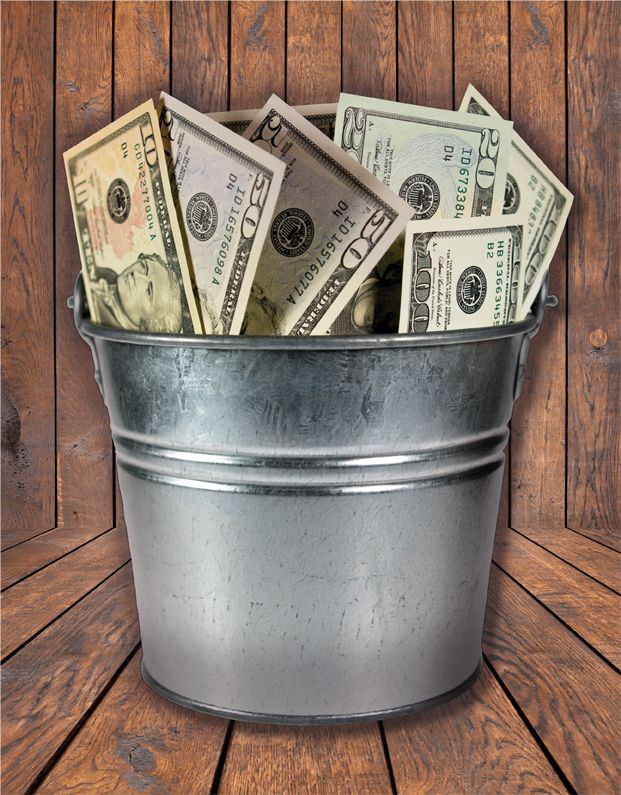Money Buckets: Managing Retirement Investments

 Buckets. Whether they’re used out in the garden, in the closet next to the mop, in the garage for storage, or even decorative buckets as interior décor … they are a staple in almost every household across America. But in my business of investment planning, I use buckets in a very different way: for money. No, I don’t mean that I have buckets and buckets of money lying around (although much like you, I wish that were the case!). I use buckets as a way to illustrate to my clients how their money and investments will be structured as they approach and hopefully enjoy retirement. Thinking in terms of placing investments in different “buckets” can be an effective tool to help clients better understand their retirement portfolio and feel more comfortable with their investments during a very volatile period in the financial markets.
Buckets. Whether they’re used out in the garden, in the closet next to the mop, in the garage for storage, or even decorative buckets as interior décor … they are a staple in almost every household across America. But in my business of investment planning, I use buckets in a very different way: for money. No, I don’t mean that I have buckets and buckets of money lying around (although much like you, I wish that were the case!). I use buckets as a way to illustrate to my clients how their money and investments will be structured as they approach and hopefully enjoy retirement. Thinking in terms of placing investments in different “buckets” can be an effective tool to help clients better understand their retirement portfolio and feel more comfortable with their investments during a very volatile period in the financial markets.
Here’s how the concept of buckets works: In retirement planning, once you’ve done all the necessary planning, budgeting, and calculating, and have figured out your risk tolerance, income needs, diversification strategy, and picked your investments, then you break out the buckets! Three of them to be exact, for your short-term, medium-term, and long-term investments. This is not a specific investment plan that needs to be followed to a “T”; it’s just a way to help you better understand how your investments can be structured to provide some measure of protection for your money in the short term and give it an opportunity to grow in the long term. And like all investments and plans, it should be customized to help you work toward your own specific needs and goals. While diversification (or asset allocation) does not ensure a profit and may not protect against loss, it can play a key role in establishing a sound investment strategy and reducing risk.
 Bucket 1 is your Short-Term Bucket. This is typically the most conservative of all buckets because it should provide the immediate income you will need for the next three years. This bucket is usually made up of cash and cash-equivalent investments, which you should be able to count on for the next three years. The Short-Term Bucket is the one that should provide comfort when the market is at its most volatile, because regardless of what happens in the market, you potentially have three years’ worth of income in this bucket. It also gives your other two buckets more time to weather market fluctuations, before you will need to access that money.
Bucket 1 is your Short-Term Bucket. This is typically the most conservative of all buckets because it should provide the immediate income you will need for the next three years. This bucket is usually made up of cash and cash-equivalent investments, which you should be able to count on for the next three years. The Short-Term Bucket is the one that should provide comfort when the market is at its most volatile, because regardless of what happens in the market, you potentially have three years’ worth of income in this bucket. It also gives your other two buckets more time to weather market fluctuations, before you will need to access that money.
Bucket 2 is your Medium-Term Bucket. The investments in this bucket are a bit more aggressive than Bucket 1, since you are looking for more return or yield from these investments. In many cases, though everyone’s plan is different, this bucket will contain many of your fixed income investments. Bonds of all kinds, preferred stocks, and even longer-term CDs can be used to fill this bucket. The time horizon—the amount of time before you plan to access this money—for this bucket is generally in the neighborhood of three to seven years.
Bucket 3 is your Long-Term Bucket and typically has a time horizon of seven years and up. This is the place for the equity portion of your portfolio, as equities generally have the biggest risk/reward ratio of all of the investment types we have discussed. It’s probably a good idea to incorporate equities in your portfolio to some degree, regardless of what stage of your plan you are currently in. By placing them in your Long-Term Bucket, you can create a buffer of many years before needing to use this money.
 To summarize the bucket concept: The goal of the Short-Term Bucket is to help protect the money you will need in the next three years regardless of market fluctuations. The Medium-Term Bucket has more conservative investments that won’t be needed for a few years and may offer greater total return. And the Long-Term Bucket contains the risk/reward equity portion of the portfolio, allowing plenty of time to account for market fluctuations before it’s needed.
To summarize the bucket concept: The goal of the Short-Term Bucket is to help protect the money you will need in the next three years regardless of market fluctuations. The Medium-Term Bucket has more conservative investments that won’t be needed for a few years and may offer greater total return. And the Long-Term Bucket contains the risk/reward equity portion of the portfolio, allowing plenty of time to account for market fluctuations before it’s needed.
It’s also important to think about the flow of money through the buckets during retirement—from your riskier long-term investments into your more protected, short-term investments. Each year as the money comes out of Bucket 1 to satisfy your income needs, it is replenished with money from Bucket 2, which in turn is replenished from Bucket 3. This means Bucket 1, the Short-Term Bucket, is always full and capable of providing you with the income you need.
Who knew? In addition to all of their other uses around the home, buckets can also help you to better understand your investment plan, hopefully giving you one less thing to worry about as you enjoy your retirement.
Rich Roth is a financial advisor with Stifel, Nicolaus & Company, Incorporated and also hosts “Investment GamePlanning 101” Saturday mornings at 9 on WLNI-FM.
Rich also teaches continuing education
classes “Investing Basics” and “Investing
for Retirement” at Central Virginia Community College.






